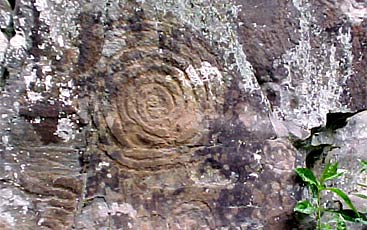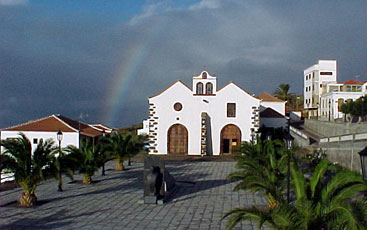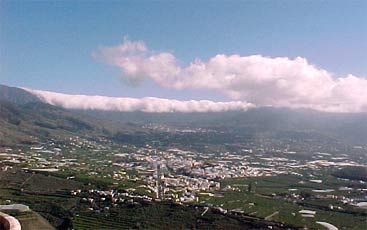
The Island of Benahoare
Ancient Canary Islands home of the Guanches

- Petroglyph of the Guanches at La Zarza
Already in the Neolithic period from ca. 2500 B. C. Benahoare, as the native population of the Guanches called their island, was first settled from North Africa. Between 800 and 900 BC, a second wave of immigrants reached the island. The island was divided into 12 kingdoms and the inhabitants lived, apart from small quarrels, mostly peacefully and in mutual respect for the neighbouring tribes and families. The people fed on the fruits the island offered, cultivated a little agriculture and cattle and fished on the side.
The Benahoarites worshipped the sun they called Abora as a goddess and celebrated their religious ceremonies at places of worship, such as the Roque Idafe, in the middle of the Caldera de Taburiente. The cycle of the moon allowed the indigenous people to calculate a rough time division. Everywhere on the island there are excavation sites, for example in La Zarza, which can be reached by rental car in 15 minutes from Puntagorda, or in the south-east of the island the Cueva del Belmaco, the oldest site on La Palma, at around 4000 years of age.
The Island of San Miguel de La Palma
The Invincible falls through a war list after over 90 years

- Garafia - Village Church from the Colonial Period
As early as around 1402 AD, the Norman nobleman Jean de Bethencourt tried to conquer the island, but this failed because of the fierce resistance of the island's inhabitants. The Castilian Count Hernan Peraza also set out in 1447 to subjugate the invincible. The Benahoaritas sent him home with 200 dead soldiers in their luggage. Between September 1492 and May 1493 the Spanish general Alonso Fernandez de Lugo was able to take up a large part of the island with an army of 900 men. Only the last king of Benahoare, the unbending Tanausu of Acero, resisted the conquest, entrenched in the Caldera de Taburiente, until the end. Only an already christianized relative of Tanausu, Juan de Palma, succeeded in using false promises to lure the king out of the Caldera into an ambush, where he was captured by the Spanish troops. After the subjugation, San Miguel de La Palma, as the island was called from then on, became part of the Spanish crown. Because La Palma promised great wealth, immigrants from Spain, Portugal, Italy and Mallorca came to the island and merged with the indigenous people to form the tribe of today's population.
The language of the Guanches died out in the 17th century.
La Isla Bonita
Modern urban life and rural flair in original villages

- Los Llanos - Cultural Life
Today La Palma is an island with a good infrastructure, but it has retained its tranquillity and charm. The facilities of daily life are on a European level, and agriculture combined with gentle tourism has brought the Isla Verde a modest prosperity. A rich cultural life with many festivals and traditional events throughout the year make the island a place worth living and loving. About 150.000 tourists come to La Palma every year, many of them cannot resist the magical beauty of the island and remain forever. At the moment there are about 12000 foreigners living on the Isla Bonita.
